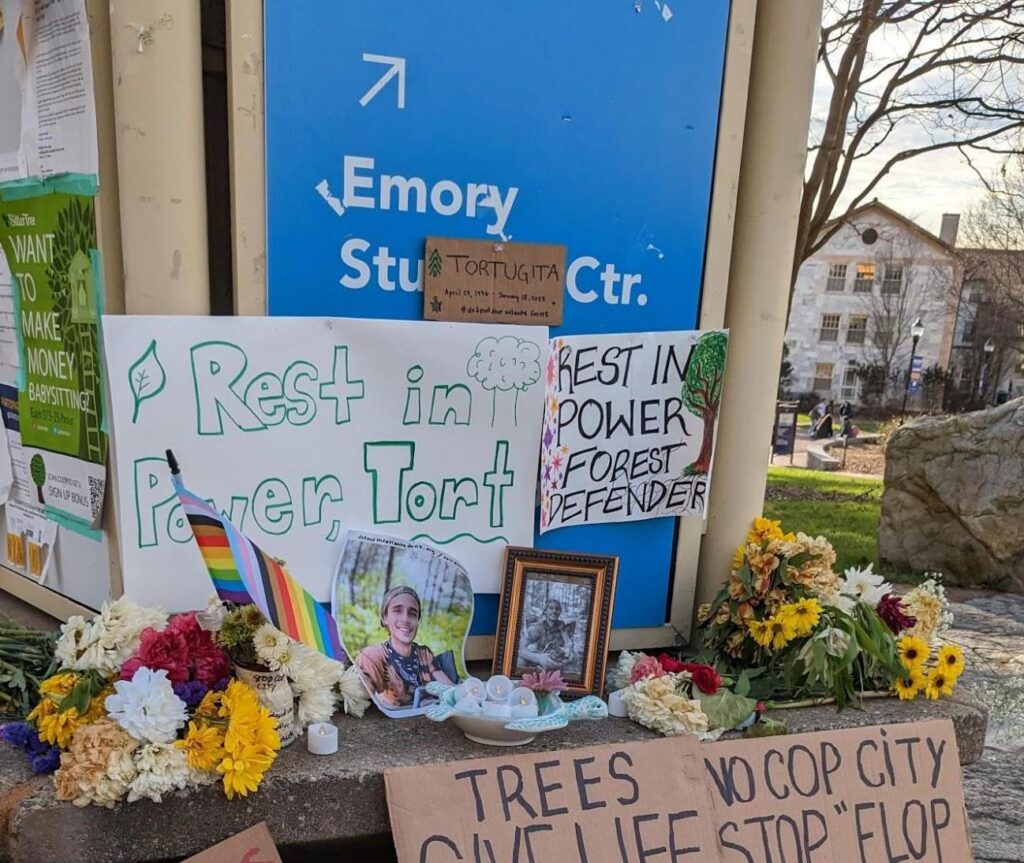News Team member Jordyn Rosenberg explores the ways that text-based crisis-support lines meet disasters, and afterwards gather data from them
Development at Atlanta’s “Cop City” Poses Environmental Health Risks
The planned loss of tree canopy and likely pollution evoke histories of redlining and environmental racism
by Gabrielle Stearns
National attention has focused on a small forest on the outskirts of Atlanta, due to civic unrest over plans by the Atlanta Police Foundation to build a new police and firefighter training facility.
Land clearing has started, stopped and restarted at the Public Safety Training Center, dubbed “Cop City” by community activists. The Atlanta Police Foundation’s proposal includes classrooms, administrative buildings, a training fire station, firing ranges, a mock village for police training, green spaces, and more resources to be used by Atlanta police and fire departments. The facility will be built on 85 acres within the 400-acre city-owned South River Forest, which lies southeast of Atlanta.
The plans have been met with significant community backlash. Several organizations, including Stop Cop City and Defend the Atlanta Forest, have organized protests in the forest. Some resulted in confrontations with the police, leading to dozens of arrests, domestic terrorism charges, and the death of activist Manuel “Tortugita” Terán.

Protestors of the project oppose two major aspects of the Public Safety Training Center: increased police presence and environmental damage in the forest.
Linking environmental damage to neighborhood health
Activists challenge the Atlanta Police Foundation’s report that the forest vegetation due to be removed is primarily invasive shrubs and softwood trees, saying that their own assessments have found native plants and trees more than 300 years old. If their land survey is correct, the loss of vegetation from construction would be significant. Trees not only provide shade and temperature control; studies show they may also affect temperatures in cities by mitigating the urban heat island effect caused by roads, pavement, and concentrations of buildings. In some studies, trees reduce urban ambient temperatures by up to 1°C.
Activists and researchers are also concerned about environmental hazards of construction, along with the eventual planned uses of the facility. Dr. Dana Barr, a professor at Emory’s Rollins School of Public Health who researches the effects of environmental exposures on health, has concerns for the health of nearby communities. She specifically points to the dangers of the firefighter training area and outdoor firing range.
“There’s a real problem near airports or fire stations or places where they often have firefighting foams there because it gets into the groundwater,” she explained. Firefighting foam contains chemicals from a group called per- and polyfluoroalkyl substances (PFAS). PFAS are referred to as “forever chemicals” because they don’t break down on their own. When humans are exposed, these chemicals can cause issues with growth and development, reproduction, thyroid and liver function, and more.
“Once it gets into the groundwater, it can get into the municipal water, and municipal water systems really don’t have efficient filters for getting out the PFAS,” said Dr. Barr.
The firing range poses similar issues. Firearms emit several chemicals when fired, including lead which is known to be toxic to humans. “These metals will get into the soil and they will naturally migrate into the water systems as well,” Dr. Barr explained.
Evoking histories of redlining and environmental racism
The people living in the neighborhoods directly surrounding the South River Forest will be hit the hardest by these environmental exposures. At least 50% of residents in all nearby zip codes are Black according to 2020 US Census Data, but that number is closer to 90% in most of the neighborhoods.
Environmental justice advocates point to these demographics to explain how the building of the Public Safety Training Center is an example of environmental racism. Environmental racism describes practices of harming the environment in areas with high minority populations in ways that disproportionately affect their lives and health. Other examples include putting in a landfill or removing greenspace in neighborhoods where most of the residents belong to racial minority groups.
Looking back at histories of discriminatory development and environmental racism reveals how siting the training center next to historically Black neighborhoods evokes long-ago injustices.
The Home Owners’ Loan Corporation (HOLC) created color-coded maps of over 200 US cities during the Great Depression in the 1930s. The maps were meant to show lenders which neighborhoods were worthwhile investments at a time of economic instability, and which would be risky investments. The risky neighborhoods were colored red on these maps, leading to the term “redlining.” These redlined neighborhoods overwhelmingly contained Black residents due to the racial segregation of the time, meaning these maps were effectively keeping loans and investments, including things like infrastructure updates and parks, out of Black neighborhoods.
Dr. Sadeer Al-Kindi, a physician, scientist, and cardiologist at Case Western Reserve University Hospitals, studies how these maps created almost 100 years ago affect the health of residents in those neighborhoods today.
“We found that people who live in redlined areas have a significantly higher risk of cardiovascular risk factors for diabetes, obesity, high blood pressure, low physical activity, but also elevated risk of coronary disease, stroke, and chronic kidney disease,” Dr. Al-Kindi said.
The South River Forest is outside the area of Atlanta that was mapped by the HOLC, but Dr. Al-Kindi’s research offers a lesson about what happens when the environment and infrastructure of specific communities are neglected. The negative health effects that are likely to result from the Public Safety Training Center have the potential to last for generations.
The Atlanta Police Foundation has made efforts to account for environmental concerns. They have agreed to plant 100 new trees for every hardwood that has to be removed for construction, add greenspaces open to the public, and conduct water and soil surveys to monitor chemical levels. Activists who oppose the project believe this isn’t enough. Protests in Atlanta and the South River Forest have continued despite updates to the plan.


